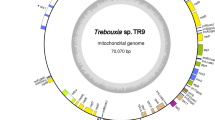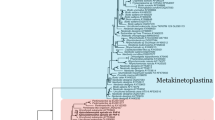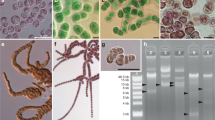Abstract
Mitochondria, organelles specialized in energy conservation reactions in eukaryotic cells, have evolved from eubacteria-like endo-symbionts 1–3 whose closest known relatives are the rickettsial group of α-proteobacteria 4,5. Because characterized mitochondrial genomes vary markedly in structure3, it has been impossible to infer from them the initial form of the proto-mitochondrial genome. This would require the identification of minimally derived mitochondrial DNAs that better reflect the ancestral state. Here we describe such a primitive mitochondrial genome, in the freshwater protozoon Reclinomonas americana6. This protist displays ultrastructural characteristics that ally it with the retortamonads7,8, a protozoan group that lacks mitochondria8,9. R. americana mtDNA (69,034 base pairs) contains the largest collection of genes (97) so far identified in any mtDNA, including genes for 5S ribosomal RNA, the RNA component of RNase P, and at least 18 proteins not previously known to be encoded in mitochondria. Most surprising are four genes specifying a multisubunit, eubacterial-type RNA polymerase. Features of gene content together with eubacterial characteristics of genome organization and expression not found before in mitochondrial genomes indicate that R. americana mtDNA more closely resembles the ancestral proto-mitochondrial genome than any other mtDNA investigated to date.
This is a preview of subscription content, access via your institution
Access options
Subscribe to this journal
Receive 51 print issues and online access
$199.00 per year
only $3.90 per issue
Buy this article
- Purchase on Springer Link
- Instant access to full article PDF
Prices may be subject to local taxes which are calculated during checkout
Similar content being viewed by others
References
Margulis, L. Origin of Eukaryotic Cells (Yale Univ. Press, New Haven, CT, 1970).
Gray, M. W. & Doolittle, W. F. Has the endosymbiont hypothesis been proven? Microbiol. Rev. 46, 1–42 (1982).
Gray, M. W. The endosymbiont hypothesis revisited. Int. Rev. Cytol. 141, 233–357 (1992).
Yang, D., Oyaizu, Y., Oyaizu, H., Olsen, G. J. & Woese, C. R. Mitochondrial origins. Proc. Natl Acad. Sci. USA 82, 4443–4447 (1985).
Gray, M. W. & Spencer, D. F. in Evolution of Microbial Life (eds Roberts, D. McL, Sharp, P., Alderson, G. & Collins, M.) 109–126 (Cambridge Univ. Press, 1996).
Flavin, M. & Nerad, T. A. Reclinomonas americana N. G., N. Sp., a new freshwater heterotrophic flagellate. J. Euk. Microbiol. 40, 172–179 (1993).
O'Kelly, C. J. The jakobid flagellates: structural features of Jakoba, Reclinomonas and Histiona and implications for the early diversification of eukaryotes. J. Euk. Microbiol. 40, 627–636 (1993).
Brugerolle, G. & Mignot, J.-P. in Handbook of Protoctista (eds Margulis, L., Corliss, J. O., Melkonian, M. & Chapman, D. J.) 259–265 (Jones and Bartlett, Boston, 1990).
Cavalier-Smith, T. Eukaryotes with no mitochondria. Nature 326, 332–333 (1987).
Lang, B. F., Goff, L. J. & Gray, M. W. A 5 S rRNA gene is present in the mitochondrial genome of the protist Reclinomonas americana but is absent from red algal mitochondrial DNA. J. Mol. Biol. 261, 607–613 (1996).
Gray, M. W. in The Molecular Biology of Plant Mitochondria (eds Levings, C. S. III & Vasil, I. K.) 635–659 (Kluwer Academic, Dordrecht, The Netherlands, 1995).
Wolff, G., Plante, I., Lang, B. F., Kück, U. & Burger, G. Complete sequence of the mitochondrial DNA of the chlorophyte alga Prototheca wickerhamii. J. Mol. Biol. 237, 75–86 (1994).
Masters, B. S., Stohl, L. L. & Clayton, D. A. Yeast mitochondrial RNA polymerase is homologous to those encoded by bacteriophages T3 and T7. Cell 51, 89–99 (1987).
Chen, B., Kubelik, A. R., Mohr, S. & Breitenberger, C. A. Cloning and characterization of the Neurospora crassa cyt-5 gene. A nuclear-coded mitochondrial RNA polymerase with polyglutamine repeat. J. Biol. Chem. 271, 6537–6544 (1996).
Bogorad, L. in The Molecular Biology of Plastids (eds Bogorad, L. & Vasil, I. K.) 93–124 (Academic, San Diego, 1991).
Reith, M. Molecular biology of rhodophyte and chromophyte plastids. Annu. Rev. Plant Physiol. Plant Mol. Biol. 46, 549–575 (1995).
Cermakian, N., Ikeda, T. M., Cedergren, R. & Gray, M. W. Sequences homologous to yeast mitochondrial and bacteriophage T3 and T7 RNA polymerases are widespread throughout the eukaryotic lineage. Nucleic Acids Res. 24, 648–654 (1996).
Ito, K. Protein translocation genetics. Adv. Cell. Mol. Biol. Membr. Organelles 4, 35–60 (1995).
Glick, B. S. & von Heijne, G. Saccharomyces cerevisiae mitochondria lack a bacterial-type Sec machinery. Prot. Sci. 5, 2651–2652 (1996).
Oda, K. et al. Gene organization deduced from the complete sequence of liverwort Marchantia polymorpha mitochondrial DNA. A primitive form of plant mitochondrial genome. J. Mol. Biol. 223, 1–7(1992).
Burger, G., Plante, I., Lonergan, K. M. & Gray, M. W. The mitochondrial DNA of the amoeboid protozoon, Acanthamoeba castellanii: complete sequence, gene content and genome organization. J. Mol. Biol. 245, 522–537 (1995).
Burger, G., Lang, B. F., Reith, M. & Gray, M. W. Genes encoding the same three subunits of respiratory complex II are present in the mitochondrial DNA of two phylogenetically distant eukaryotes. Proc. Natl Acad. Sci. USA 93, 2328–2332 (1996).
Gray, M. W. Origin and evolution of organelle genomes. Curr. Opin. Genet. Dev. 3, 884–890 (1993).
Shine, J. & Dalgarno, L. The 3′-terminal sequence of Escherichia coli 16S ribosomal RNA: complementarity to nonsense triplets and ribosome binding sites. Proc. NatlAcad. Sci. USA 71, 1342–1346 (1974).
Wise, C. A. & Martin, N. C. Dramatic size variation of yeast mitochonodrial RNAs suggests that RNase P RNAs can be quite small. J. Biol. Chem. 266, 19154–19157 (1991).
Lee, Y. C., Lee, B. J. & Kang, H. S. The RNA component of mitochondrial ribonuclease P from Aspergillus nidulans. Eur. J. Biochem. 235, 297–303 (1996).
Darr, S. C., Brown, J. W. & Pace, N. R. The varieties of ribonuclease P. Trends Biochem. Sci. 17, 178–182 (1992).
Siegel, R. W., Banta, A. B., Haas, E. S., Brown, J. W. & Pace, N. R. Mycoplasma fermentans simplifies our view of the catalytic core of ribonuclease P RNA. RNA 2, 452–462 (1996).
Fraser, C. M. et al. The minimal gene complement of Mycoplasma genitalium. Science 270, 397–403 (1995).
Fleischmann, R. D. et al. Whole-genome random sequencing and assembly of Haemophilus influenzae Rd. Science 269, 496–512 (1995).
Author information
Authors and Affiliations
Rights and permissions
About this article
Cite this article
Lang, B., Burger, G., O'Kelly, C. et al. An ancestral mitochondrial DNA resembling a eubacterial genome in miniature. Nature 387, 493–497 (1997). https://doi.org/10.1038/387493a0
Received:
Accepted:
Issue Date:
DOI: https://doi.org/10.1038/387493a0
This article is cited by
-
Mitochondrial genomes revisited: why do different lineages retain different genes?
BMC Biology (2024)
-
Putting human Tid-1 in context: an insight into its role in the cell and in different disease states
Cell Communication and Signaling (2022)
-
Crystalline silica induces macrophage necrosis and causes subsequent acute pulmonary neutrophilic inflammation
Cell Biology and Toxicology (2022)
-
Mitochondria in the Pathogenesis of Systemic Lupus Erythematosus
Current Rheumatology Reports (2022)
-
First Genome of Labyrinthula sp., an Opportunistic Seagrass Pathogen, Reveals Novel Insight into Marine Protist Phylogeny, Ecology and CAZyme Cell-Wall Degradation
Microbial Ecology (2021)
Comments
By submitting a comment you agree to abide by our Terms and Community Guidelines. If you find something abusive or that does not comply with our terms or guidelines please flag it as inappropriate.



